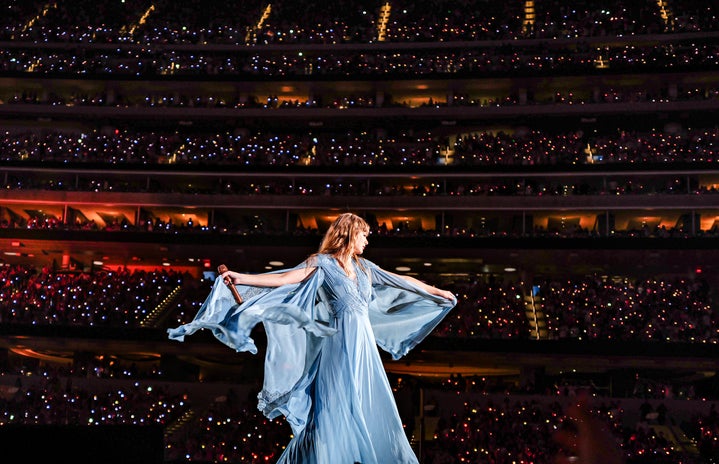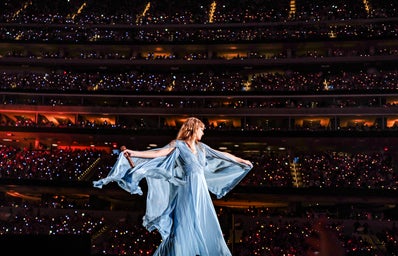When I was five, I got my first American Girl doll. For the next seven years, they were my everything. Around that time, Taylor Swift’s discography was getting larger and larger. At age eight, I was the expert on all things American Girl. At age 18, I became a Swiftie guru who informed herself on the ins and outs of each of Swift’s eras. Today, I will be combining these Roman Empires of my past and present to see which historical American Girl dolls fit into each of Swift’s eras.
Kirsten Larson as taylor swift
To kick off the first Taylor Swift album ever released, we have Kirsten Larson (1854). By age 10, Kirsten’s house burned down, her best friend died from cholera, and her new best friend moved away right when their friendship was growing stronger. None of these compare to the vulnerabilities teenage Swift expresses in these nostalgic bops on Taylor Swift, but they do reflect upon the hardships of growing up and feeling naïve, which are things Kirsten also struggles with.
Also, in terms of looks, there’s no American Girl doll that embodies young Taylor Swift more perfectly than Kirsten. It’s not hard to picture Swift wearing modern versions of Kirsten’s dresses at a performance in a Nashville bar.
Felicity Merriman as Fearless
Felicity Merriman (1771) is #notlikeothergirls, and so is Swift in her Fearless era. First off, Felicity’s dresses scream “Today Was a Fairytale.” Swift may have been maturing in her sound and style, but this album still reverts to her country roots, with cute dresses and horse girl energy like Felicity’s. Both Felicity and Swift have coming-of-age stories where they start questioning societal pressures that curtail their every move.
Rebecca Rubin as Speak Now
We’ve arrived at my favorite album and one of my favorite dolls, Rebecca Rubin (1914). Rebecca is an aspiring actress. There’s a plethora of purple and pink dresses included in her old and new collections. This girl and her story are the definition of Speak Now. Sweet, dramatic, and confident, Rebecca would definitely write an album entirely on her own where she calls out ex-partners for their wrongdoings and emblazons the lyrics with her dreams for the future. So long live all the magic she made!
Samantha Parkington as Red
Red is the embodiment of chaos, and Samantha Parkington (1904) is the embodiment of a messy life at age nine. From losing her parents in a boating accident to standing up for child labor laws and physically rescuing her best friend from an orphanage, Samantha’s been through it. Like the queen she is, Samantha would proudly sit in her Victorian garb and write a masterpiece of an album that goes into excruciating detail about the triumphs and tragedies of the last few years of her life.
For Swift, Red marked her transition period from country to pop. For Samantha, her story transitions from social conformity to suffrage and advocacy.
Julie Albright as 1989
Julie Albright (1974) is a ’70s doll, not an ’80s doll, I know. However, Julie is the epitome of girlboss energy, and 1989 is all about the bright colors and the single girlies who are killing it. Julie not only has the brightest, most colorful wardrobe of any American Girl doll, but she also fights to get girls on the school basketball team, saves bald eagles, and stands up for her friend who is deaf, all while persevering through a difficult family situation. Seriously, Julie is clearly blasting “Style” and “How You Get the Girl” as she slays each day away.
Molly McIntire as Reputation
Molly McIntire (1944) is in her Reputation era. This girl is in the thick of it. Her dad leaves for World War II, and mashed turnips become a staple in her diet, which turns Molly’s world upside down. Molly feels like the universe is against her. While Molly was not humiliated online or referred to as a “snake,” her circumstances are strikingly similar to those experienced by Swift in 2016 which resulted in the Reputation album. Both Swift and Molly have some good highlights from this era, like forming new relationships, but the overall anxious, angry vibes are the focus of their stories. Can’t you just picture Molly in a tight, black, snake-adorned fit screaming “Don’t Blame Me”?
Addy Walker as Lover
When you think of Lover, you think bright pink, and Addy Walker’s (1864) stunning historical dress is just that. Lover is an album that focuses on enjoying life’s small moments as well as navigating life’s major obstacles. This theme is synonymous with Addy’s story. Her determination, resilience, and collection of blue and pink dresses perfectly frame her into this era, and you can’t deny it.
Kaya as Folklore
Kaya’aton’my (1764) is seemingly the most courageous girlie out there. Defending herself and her tribe against both wild animals and colonizers would probably lead to some descriptive, biographical writing. Kaya also has strong connections to people and nature, and these symbols in her stories and the songs on this album refer to many people and symbols significant to Swift’s life. It just makes sense!
Josefina Montoya as Evermore
For some reason, we forget Josefina Montoya (1824) exists in the historical American Girl doll collection. Similarly, after Evermore was released, we thought Swift had completely forgotten about its existence, but the Eras Tour proved us all wrong. Josefina is a nature girlie with a lot of feelings to grasp as she navigates numerous family hardships. Her outfits give off the warm, forest-like aesthetic that’s synonymous with this album. Can’t you envision her writing and painting in the Evermore cabin?
Caroline Abbott as Midnights
Caroline Abbott (1812) was retired just three years after her initial release, but she still made her mark on me. Her story is powerful: She literally defended herself and her family’s possessions when the British attacked her town during the War of 1812. She’s strong and she’s also got a wild story going on. The Midnights era is all about sleepless nights, which we can assume Caroline had a ton of as she tried to protect herself and her family at all costs. If that’s not enough to convince you, this blue coat totally matches Swift’s color pallete from this era.
And there you have it: the American Girl dolls as their respective Taylor Swift eras. And, just for fun, check out this hilarious clip of Conan O’Brien mansplaining American Girl Dolls.
Want to see more HCFSU? Be sure to like us on Facebook and follow us on Instagram, Twitter, TikTok, and Pinterest!


